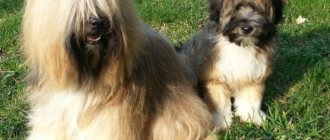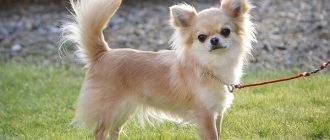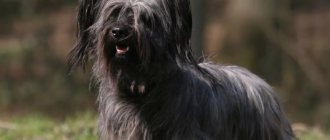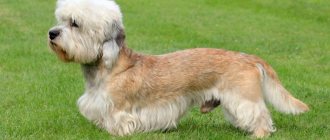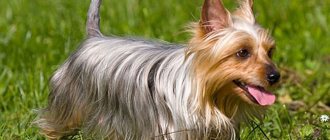The Czech (another name for the Bohemian) terrier is a relatively young and rare breed intended for burrow hunting. The dogs have excellent working qualities and at the same time they are so attractive that they are loved by the fair half of humanity. The Czech Terrier is a wonderful hunter, an excellent watchman, a faithful companion and just a beautiful dog.
History of the breed
The Czech Terrier was developed in 1948. The creator of this breed was Frantisek Horak. An amateur dog handler set the task of breeding a small terrier that, in the conditions of the Czech Republic, would be suitable for hunting and would be able to crawl into narrow holes. Two breeds were chosen for breeding - a female Scotch Terrier and a male Sealyham Terrier. Subsequently, Gorak worked with the resulting offspring, achieving the desired result. In 1963, the world saw the Czech Terrier, which differed from its parents in its more graceful build, excellent working qualities and good-natured disposition. Currently, this is one of the rarest breeds, the puppies of which are very difficult to find.
Origin story
The Czech Terrier is an original breed, that is, it owes its appearance to a certain person, namely Frantisek Horak, an amateur breeder from Klanowice, a suburb of Prague. Horak set himself a goal - to breed a small, light terrier that would be suitable for burrow hunting in the conditions of the Czech Republic. In other words, it was supposed to be a Sealyham Terrier, but lighter in build and darker in color.
Then he would be able to crawl into narrow holes and get dirty less. In 1948, Frantisek Horak bred a male Sealyham Terrier with a female Scottish Terrier. Then I worked with the resulting litter. Already in 1959, the Czech Terrier was first shown at an exhibition, and in 1963 the breed was officially recognized by the International Canine Federation, but it still remains one of the rarest in the world.
The Czech Terrier, due to its inherent calmness, may not seem as reckless as many other burrowing dogs, but it has a developed hunting instinct and a good sense of smell. Its narrow body and short legs allow it to easily penetrate into the burrows of martens, muskrats and wider badger or fox burrows.
The task of the Czech Terrier when hunting is standard for burrowing breeds: to find a living hole and drive the animal out of there, or to drive it into a corner and chase it until a person comes to the rescue. If successful, the dog strangles the animal and drags it out itself. In the Czech Republic, terriers are also trained to hunt pheasants and other birds.
We suggest you read: Caring for newborn puppies
The Czech Terrier is a signature dog breed bred by František Horák, an amateur breeder from Klanowice near Prague. Gorak set himself the goal of creating a small, light dog that could take part in burrow hunting. It was planned differently to create a Sealyham Terrier, which would be characterized by a light build and dark coat color, so that such an animal could easily crawl through narrow holes without getting dirty.
In 1948, the scientist crossed a male Sealyham Terrier and a female Scotch Terrier. After the puppies appeared, he worked with babies. The first display of the Czech Terrier took place at an exhibition in 1959, and 4 years later the breed was officially recognized by the International Canine Federation. Today, representatives of the breed are considered rare dogs.
Czech Terrier standard
Representatives of the breed are distinguished by a moderately elongated body, externally reminiscent of both parent forms, short legs, and an elongated muzzle. Basic standards:
- The height of the dog at the withers is 25-30 cm (ideally the size for females is 26 cm, for males - 28-29 cm).
- Weight - from 6 to 9 kg.
- The body is elongated, squat, strong.
- The chest is elongated and voluminous.
- The abdomen is slightly retracted, moderately tucked.
- The back is straight.
- The croup is muscular, well developed, often just above the withers.
- The head is long, wedge-shaped, the forehead is flat, the transition to the muzzle is weakly expressed, but noticeable. There is a mustache and beard.
- The neck is of medium length, slightly inclined forward.
- The paws are short, covered with a “skirt”. The hind legs are much more powerful to provide good propulsion when running. Movements are smooth, dexterous and fast.
- The nose is brown or black depending on the color of the dog.
- The eyes are round, small, covered on top with characteristic bushy eyebrows.
- The ears are hanging, adjacent to the head, triangular in shape.
- The length of the tail is 18-20 cm. When the dog is calm, it is lowered, when excited, it is raised.
- Life expectancy is up to 12 years.
Care and maintenance
The thick coat of this breed requires constant brushing. The Czech Terrier requires regular haircuts - once every two to three months. If the animal is kept in an apartment, it must be walked. This should take at least 40 minutes a day. This breed requires moderate exercise. Although the dog is very resilient, you should not exhaust him too much. After each feeding, wipe the pet's face with a damp cloth. The fur on the face should be lightly combed, since the mustache and beard end up in the bowl. You need to bathe your Czech Terrier when necessary. The dog should always have the opportunity to drink fresh water. Both bowls - for eating and drinking - are cleaned regularly. It is impossible to overfeed or underfeed the animal.
Personality of the Czech Terrier
A dog of this breed is distinguished by its tireless hard work, and it gladly uses this quality at work. She tries to do more than others, to be in time before everyone else. And all this just to be praised by the owner. Thanks to their tenacity and endurance, Czechs are a valuable working breed. Burrowing dogs are excellent at hunting animals such as badgers, foxes and small predators. In addition, they are wonderful watchmen who treat strangers, although with distrust, but without much aggression. These cute dogs look very impressive and are good companions. “Czechs” become very attached to their owners and feel sad when they are left alone at home. This greatly affects their behavior. Left alone, they “have a blast” on various objects.
But in the family circle, the Czech Terrier behaves completely differently. He becomes a pleasant and calm dog, trying in any way to get praise from his owner. Can find a common language with all family members. The Czech Terrier is quite loyal to other animals living in the house; it does not claim leadership, but it also does not allow itself to be pushed around. This breed has an easy-going and gentle disposition, which makes these dogs family pets. During walks they behave quite calmly. The only animals that these burrowing dogs dislike are rodents, since their natural hunting instinct immediately awakens in them. They react instantly and can give chase.
Choosing a Czech Terrier puppy
Those wishing to purchase a Czech Terrier will have to try hard to find a kennel, not to mention puppies available for sale. The main livestock is concentrated in the Czech Republic and Great Britain; there are several breeders in other European countries and America. In Russia, very few people successfully breed Czech terriers.
The only proof of a puppy's breed are documents of the FCI-RKF sample.
Czech Terrier puppies are born black with white spots on the body and only by the age of two years they acquire their final color, from charcoal gray to almost white. It is very rare for brown puppies to appear in a litter. The color of the parents can only suggest the future color of the puppies, but does not guarantee it.
Vaccinated babies are taken no earlier than 2 months of age and their compliance with the standard and health are assessed. Externally, puppies should not show signs of illness. Parents are encouraged to have genetic tests for common diseases. It is better to pick up the puppies in person. This will allow you to see your parents live, their appearance, character and habits.
Since the breed is not commercial, and puppies are in little demand, the price of the Czech Terrier is quite reasonable. Dogs not for exhibitions and breeding cost an average of 35,000 rubles. In Europe, the average cost of a Czech Terrier puppy is 700 euros.
We are talking about a very rare, small breed, so finding Czech Terrier puppies is not so easy. Nurseries that have proven themselves to be good are located in America and the Czech Republic. Puppies are booked in advance and assessed after birth. According to generally accepted practice, the algorithm of actions is as follows:
- Contact the nursery - all organizations have websites, although most of them are in English.
- Express your wishes – gender and class (show, breed, pet) of the puppy.
- Discuss upcoming litters for which reservations are still open.
- Wait and save money, since a puppy cannot cost less than $500-600, and besides the dog, you need to purchase many accessories, pay for veterinarian services, etc.
Price, waiting periods and (most importantly) the conditions under which puppies are sold are individual factors that depend only on the owners of the kennel. The higher the prospects of the litter, the more likely it is that the puppies will be sold under a co-ownership agreement. Simply put, you will need to fulfill the conditions and only then the dog will become completely yours. Most often we are talking about one litter of puppies to continue the bloodline.
Features of care
The external attractiveness of the Czech Terrier largely depends on how well it is cared for. The dog's appearance is monitored especially carefully if it often attends exhibitions. Grooming is especially important. From childhood, puppies get used to a variety of activities that make them handsome.
Care includes:
- Regular brushing. To untangle matted dog hair on the beard, skirt and eyebrows, use a long-tooth comb. The rest of the coat is combed with a massage brush. If your pet is constantly being cut short, the procedure can be done once a week.
- A haircut. Dogs participating in exhibitions begin to be trained from the age of three months. Every 2-3 months, the hair on their back, chest, sides, tail and head is trimmed to a length of 1.5 cm. The ends of the “skirt”, beard, and eyebrow mustache are trimmed with scissors. From three months old, dogs of this breed begin to develop light, soft, adult hair, so it is at this age that they begin to be cut.
- Washing. Dogs are washed as needed approximately once every 1-2 months. For the procedure, special shampoos are used that make the coat silky, soft and easy to comb.
- Oral care. This breed is prone to dental diseases, so it is advisable to take them to the veterinarian for examinations as often as possible. It would also be a good idea to purchase a special brush to clean your dog’s teeth. To prevent plaque from appearing, she is given hard bones to gnaw on.
- Walks. These are active dogs, so it is recommended to walk them well.
So, for the Czech Terrier to be a cute and well-groomed companion, he needs a lot of exercise and a little care and health care.
Nutrition
Dogs of this breed are not particularly picky when it comes to food, they are even rather voracious. They practically know no limits and look at their owners with hungry eyes all day long. It is recommended not to indulge their touching begging, otherwise they will not leave the table while the owners are eating. This phenomenon should be stopped from early childhood.
It is also important to stop theft from puppyhood, since the dog will steal food from the table, street trash can, and pick up food from the floor. This can cause harm to his health: the animal will be poisoned, swallow a foreign object, and obesity is also possible.
It is better to feed dogs natural food. The main product in the diet should be meat, and raw meat is better, since it contains more healthy elements. Additionally, it is advisable to include vitamins and various mineral supplements.
Disadvantages of the breed
- The Czech Terrier is a rather rare breed of dog. This can cause some inconvenience for breeders.
- Despite the fact that Czechs enjoy excellent health, they can inherit from their Scottish ancestors a disease such as Scotty-Crump syndrome, in which dogs can fall into a convulsive state. Periodic occurrence of seizures affects the coordination of the Czech Terrier. This is not a fatal disease, it passes quickly enough, and the dog begins to behave as usual, but for its owner, each attack is additional stress.
- An “eternally hungry” dog can steal food wherever it is badly laid out, so it needs to be raised in such a way that it does not allow itself such antics.
Training
This is one of the few breeds of small dogs that can be easily trained. “Czechs” are smart and try to please their master, hence their great obedience. But sometimes a dog can still be stubborn. The peculiarity of the breed is intelligence, ability to learn, and perseverance.
To prevent the puppy from becoming uncontrollable, cynologists and breeders advise carrying out a number of activities for their early socialization. Some owners ignore training courses, and subsequently suffer from the uncontrollability and willfulness of their small pets, which can cause a lot of problems and troubles. Dog training should begin in early childhood. This is a good-natured animal in which aggression does not need to be trained. A pet for a family will become a real companion, a watchman, or will play with children. With proper socialization, the dog will not conflict with other animals, except, of course, rodents - its natural prey.
Training, training
Czech Terriers are easy to train.
They always try to earn the owner's approval and usually understand him perfectly. However, it is recommended to start training dogs of this breed from an early age, while the dog’s character has not yet had time to form on its own. After all, sometimes Czechs, like other terriers, can also be stubborn and headstrong, even if quite rarely. Many dog trainers recommend attending training courses. Thanks to which not only the dog will learn, but also its owner will learn how to behave correctly with the animal, learn all the subtleties of raising and training four-legged dogs. We suggest you read: What does a gray Caucasian bee look like?





